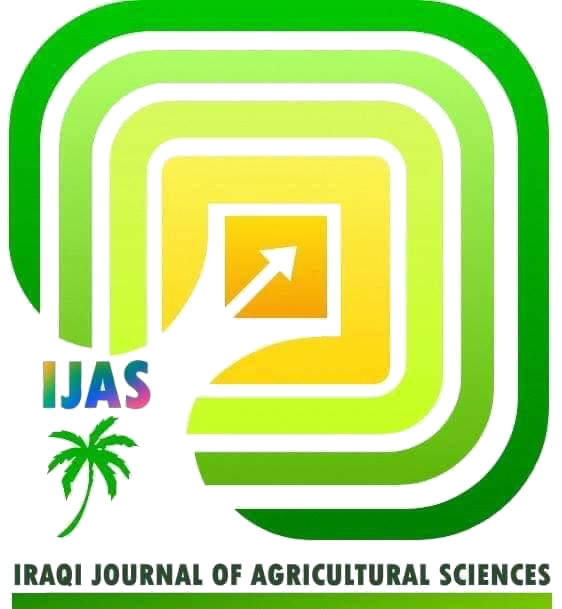EFFECTIVENESS OF BACILLUS THURINGIENSIS AS A BIOCONTROL AGENT AGAINST ROOT-KNOT NEMATODES ON TOMATO PLANT
DOI:
https://doi.org/10.36103/z9j3x831Keywords:
16s ribosomal RNA, meloidogyne spp., phylogenetic tree.Abstract
This study aimed to evaluate the nematicidal effect of three local Bacillus thuringiensis isolates in controlling the root-knot nematodes Meloidogyne spp. under laboratory and shade house conditions. We amplified 16S rRNA and performed polymerase chain reaction on the isolates to confirm them as B. thuringiensis. PCR was carried out with a universal primer for the 16S rRNA amplification for confirmation, where all three isolates yielded the predicted amplicon. The isolates were identified as B. thuringiensis and documented using sequencing based on their 16S rRNA genes. Sequencing results were deposited at NCBI. The laboratory experiments revealed that Sa.Sa.Kh.3 isolate outperformed the other two isolates, Sa.Sa.Kh.1 and Sa.Sa.Kh.2, in terms of egg hatching inhibition and second-stage juvenile mortality, reached 94.33% and 90% after 72 hours of exposure, respectively. Pot trial showed that the Sa.Sa.Kh.3 isolate reduced root gall index and improved plant growth parameters shoot fresh weight, shoot dry weight, root fresh weight, root dry weight, plant height, and root length of tomato plants by 1.33g, 77.00 g, 16.63 g, 12.15 g, 2.77 g, 88.00 cm, and 34.33, respectively, when compared to the control groups. Results showed that all isolates, both pre-nematode inoculation and post-nematode inoculation, revealed significant effects on root gall index and enhanced plant growth parameters compared to control groups.
References
1. Alkuwaiti, N. A. S., A. A. Aish, S. T. Abdulmalak, T.A. Kareem, and M. M. Sulainman. 2023. Field treatment of three wheat varieties with Trichoderma harzianum bioagent to control Anguina tritici. Journal of Applied Biology and Biotechnology, 11(1): 200-204. doi.org/10.7324/JABB.2023.110128
2. Bravo, A. 2018. Biodiversity of cry toxins produced by Bacillus thuringiensis and evolution of resistance to these toxins in different insect pests. Toxicon, 149: 98-98. doi: 10.1016/j.toxicon.2018.02.010
3. Chamzurni, T., I.M. Savira, and H. Oktarina. 2023. The Application of Bacillus thuringiensis to Treat Root Knots on Pogostemoncablin Benth. The 4th International Conference on Agriculture and Bio-industry. IOP Conf. Ser Earth Environ. Sci,1183, 012094.
doi.org/10.1088/1755-1315/1183/1/012094
4. Chen, L., Y. Wang, L. Zhu, Y. Min, Y. Tian, Y. Gong, and X. Liu. 2024 .3-(Methylthio)Propionic Acid from Bacillus thuringiensis berliner exhibits high nematicidal activity against the root knot nematode Meloidogyne incognita (Kofoid and White) chitwood. International Journal of Molecular Sciences, 25(3): 1708. doi.org/10.3390/ijms25031708
5. Choudhury, B. C. 1980. Effect of different inoculum levels of Meloidogyne incognita on two tomato varienties. Bangladesh Journal of Agricultural Research, 5: 13-16.
6. El-kersh, T. A., Y.A. Al-sheikh, R.A. Al-akeel, and A.A. Alsayed. 2012. Isolation and characterization of native Bacillus thuringiensis isolates from Saudi Arabia. African Journal of Biotechnology, 11(8): 1924-1938. doi.org/10.5897/AJB11.2717
7. El-Nagdi, W. M. A., and H. Abd-El-Khair. 2019. Application of Bacillus species for controlling root-knot nematode Meloidogyne incognita in eggplant. Bulletin of the National Research Centre, 43:154. doi.org/10.1186/s42269-019-0187-6
8. Elsharkawy, M. M., M. Nakatani, M. Nishimura, T. Arakawa, M. Shimizu, and M. Hyakumachi. 2015. Control of tomato bacterial wilt and root-knot diseases by Bacillus thuringiensis CR-371 and Streptomyces avermectinius NBRC 14893. Acta Agriculturae Scandinavica, Section B—Soil & Plant Science, 65(6): 575-580. doi.org/10.1080/09064710.2015.1031819
9. Engelbrecht, G., I. Horak, P.J. Jansen van Rensburg, and S. Claassens. 2018. Bacillus-based bionematicides: development, modes of action and commercialisation. Biocontrol Sci Techn, 28: 629-653. doi.org/10.1080/09583157.2018.1469000
10. Guo, S., M. Liu, D. Peng, S. Ji, P. Wang, Z. Yu, and M. Sun. 2008. New strategy for isolating novel nematicidal crystal protein genes from Bacillus thuringiensis strain YBT-1518. Applied and Environmental Microbiology, 74(22): 6997-7001. doi.org/10.1128/AEM.01346-08
11. Hussey, R. S., and K.R. Barker. 1973. Comparison of methods for collecting inocula of Meloidigyne spp. including a new technique. Plant Disease Reporter.57: 1025-1028.
12. Jouzani, G. S., A. Seifinejad, A. Saeedizadeh, A. Nazarian, M. Yousefloo, S. Soheilivand, M. Mousivand, R. Jahangiri, M. Yazdani, R.M. Amiri, and S. Akbari. 2008. Molecular detection of nematicidal crystalliferous Bacillus thuringiensis strains of Iran and evaluation of their toxicity on free-living and plant-parasitic nematodes. Canadian Journal of Microbiology, 54: 812-822. doi.org/10.1139/W08-074
13. Liang, Z., Q. Ali, Y. Wang, G. Mu, X. Kan, Y. Ren, H. Manghwar, Q. Gu, H. Wu, and X. Gao. 2022. Toxicity of Bacillus thuringiensis strains derived from the novel crystal protein Cry31Aa with high nematicidal activity against rice parasitic nematode aphelenchoidesbesseyi, International Journal of Molecular Sciences, 23(15):8189. doi.org/10.3390/ijms23158189
14. Martínez-Viveros, O., M.A. Jorquera, D.E. Crowley, G. Gajardo, and M.L. Mora. 2010. Mechanisms and practical considerations involved in plant growth promotion by rhizobacteria. J. Soil Sci. Plant Nutr,10(3): 293-319. doi.org/10.4067/S0718-95162010000100006
15. Maulidia, V., L. Soesanto, Syamsuddin., K. Khairan, T. Hamaguchi, K. Hasegawa, and R. Sriwati. 2020. Secondary metabolites produced by endophytic bacteria against the Root-Knot Nematode (Meloidogyne sp.). Biodiversitas Journal of Biological Diversity, 21(11): 5270-5275. doi.org/10.13057/biodiv/d211130
16. Mohammed, H.J. and S.T.A.M. Yass. 2020. Activity of fulvic acid and magnesium oxide against root knots nematode Meloidogyne spp development and disease incidence on tomato. Biochemical & Cellular Archives, 20(1): 397-401. doi.org/10.35124/bca.2020.20.1.397
17. Mohammed, S. H., M.A. El Saedy M.R. Enan, N.E. Ibrahim, A. Ghareeb, and S.A. Moustafa. 2008. Biocontrol efficiency of Bacillus thuringiensis toxins against root-knot nematode, Meloidogyne incognita. Journal of Cell and Molecular Biology, 7(1): 57-66.
18. Oliveira, D. F., V.A. Costa, W.C. Terra, V.P. Campos, P.M. Paula, and S.J. Martins. 2019. Impact of phenolic compounds on Meloidogyne incognita in vitro and in tomato plants. Experimental Parasitology, 199: 17-23. doi.org/10.1016/j.exppara.2019.02.009
19. Perry, R. N., M. Moens, and J.L. Star. 2009. Root-knot nematodes. Wallingford. UK: CABI. 55-97.
20. Ramalakshmi, A., R. Sharmila, M. Iniyakumar, and V. Gomathi. 2020. Nematicidal activity of native Bacillus thuringiensis against the root knot nematode, Meloidogyne incognita (Kofoid and White). Egyptian Journal of Biological Pest Contro, (30) 90: 293.
doi.org/10.1186/s41938-020-00293-2
21. Ravari, S. B., and E.M. Moghaddam. 2015. Efficacy of Bacillus thuringiensis Cry14 Toxin against Root Knot Nematode, Meloidogynejavanica. Plant Protect. Sci, 51(1): 46-51. doi.org/10.17221/93/2013-PPS
22. Santos, J.B.D., A.D.N. Silva, P.R.M. Queiroz, B. Eckstein, and R.G. Monnerat. 2022. Selection of Bacillus thuringiensis strains toxic to Meloidogyne incognita. Pesquisa Agropecuária Tropical, 52, e73070.
doi.org/10.1590/1983-40632022v5273070
23. Sasser, J.N., and K. Krishnappa. 1980. The development of nematology on a world basis. Journal of Nematology, 12(3): 153-1587.
24. Sikandar, A., M.Y. Zhang, X.F. Zhu, Y.Y. Wang, M. Ahmed, M.F. Iqbal, and Y.X. Duan. 2019. Efficacy of Penicillium chrysogenum strain SNEF1216 against root-knot nematodes (Meloidogyne incognita) in cucumber (Cucumis sativus l.) under greenhouse conditions. Applied ecology and environmental research, 17(5): 12451-12464. doi.org/10.15666/aeer/1705_1245112464
25. Sneath, P.H.A., and R.R. Sokal. 1973. Numerical Taxonomy. Freeman, San Francisco. pp: 105.
26. Tamura, K., M. Nei, and S. Kumar. 2004. Prospects for inferring very large phylogenies by using the neighbor-joining method. Proceedings of the National Academy of Sciences (USA), 101(30):11030-11035. doi.org/10.1073/pnas.0404206101
27. Tamura, K., G. Stecher, D. Peterson, A. Filipski, and S. Kumar. 2013. MEGA6: Molecular Evolutionary Genetics Analysis version 6.0. Molecular Biology and Evolution, 30: 2725-2729. doi.org/10.1093/molbev/msab120
28. Taylor, A. L., and J.N. Sasser. 1978. Biology, identification and control of root-knot nematodes. International Nematology Project, North Carolina State University, Graphics, Raleigh, pp: 111.
29. Xiang, N., K.S. Lawrence, and P.A. Donald. 2018. Biological control potential of plant growth‐promoting rhizobacteria suppression of Meloidogyne incognita on cotton and Heterodera glycines on soybean: A review. Journal of Phytopathology, 166(7-8): 449-458.
doi.org/10.1111/jph.12712
Downloads
Published
Issue
Section
License
Copyright (c) 2025 IRAQI JOURNAL OF AGRICULTURAL SCIENCES

This work is licensed under a Creative Commons Attribution-NonCommercial 4.0 International License.

2.jpg)


